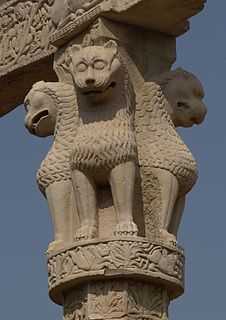
In Buddhism, a bodhisattva is any person who is on the path towards Buddhahood.

Pure Land Buddhism, also referred to as Amidism in English, is a broad branch of Mahayana Buddhism and one of the most widely practiced traditions of Buddhism in East Asia. Pure Land is a tradition of Buddhist teachings that are focused on the Buddha Amitābha. The three primary texts of the tradition, known as the "Three Pure Land Sutras", are the Longer Sukhāvatīvyūha Sūtra, Amitayurdhyana Sutra and the Shorter Sukhāvatīvyūha Sūtra.

Maitreya (Sanskrit), Metteyya (Pali), is regarded as a future Buddha of this world in Buddhist eschatology. In some Buddhist literature, such as the Amitabha Sutra and the Lotus Sutra, he is referred to as Ajita.

Chinese Buddhism or Han Buddhism has shaped Chinese culture in a wide variety of areas including art, politics, literature, philosophy, medicine and material culture.

Avalokiteśvara or Padmapani is a bodhisattva who embodies the compassion of all Buddhas. This bodhisattva is variably depicted, described and portrayed in different cultures as either male or female. In Tibet, he is known as Chenrezig, and in Cambodia as Avloketesvar. In Chinese Buddhism, Avalokiteśvara has evolved into the somewhat different female figure Guanyin, also known in Japan as Kanzeon or Kannon. In Nepal Mandal this figure is known as Jana Baha Dyah, Karunamaya, Seto Machindranath.

Shingon Buddhism is one of the major schools of Buddhism in Japan and one of the few surviving Vajrayana lineages in East Asia, originally spread from India to China through traveling monks such as Vajrabodhi and Amoghavajra.
The Lotus Sūtra is one of the most popular and influential Mahayana sutras, and the basis on which the Tiantai, Tendai, Cheontae, and Nichiren schools of Buddhism were established. According to Paul Williams, "For many East Asian Buddhists since early times the Lotus Sutra contains the final teaching of the Buddha, complete and sufficient for salvation."
Nianfo is a term commonly seen in Pure Land Buddhism. In the context of Pure Land practice, it generally refers to the repetition of the name of Amitābha. It is a translation of Sanskrit buddhānusmṛti.

The Mahāsāṃghika was one of the early Buddhist schools. Interest in the origins of the Mahāsāṃghika school lies in the fact that their Vinaya recension appears in several ways to represent an older redaction overall. Many scholars also look to the Mahāsāṃghika branch for the initial development of Mahayana Buddhism.

Buddha-nature or Buddha Principle refers to several related terms, most notably tathāgatagarbha and buddhadhātu. Tathāgatagarbha means "the womb" or "embryo" (garbha) of the "thus-gone" (tathagata), or "containing a tathagata", while buddhadhātu literally means "Buddha-realm" or "Buddha-substrate".

Samantabhadra is a bodhisattva in Mahayana Buddhism associated with practice and meditation. Together with Gautama Buddha and his fellow bodhisattva Mañjuśrī, he forms the Shakyamuni trinity in Buddhism. He is the patron of the Lotus Sutra and, according to the Avatamsaka Sutra, made the ten great vows which are the basis of a bodhisattva. In Chinese Buddhism, Samantabhadra is known as Pǔxián and is associated with action, whereas Mañjuśrī is associated with prajñā. In Japan, this bodhisattva is known as Fugen, and is often venerated in Tendai and Shingon Buddhism, and as the protector of the Lotus Sutra by Nichiren Buddhism. In the Nyingma school of Tibetan Buddhism, Samantabhadra is also the name of the Adi-Buddha – in indivisible Yab-Yum with his consort, Samantabhadrī.

Maitreya-nātha is a name whose use was pioneered by Buddhist scholars Erich Frauwallner, Giuseppe Tucci, and Hakuju Ui to distinguish one of the three founders of the Yogacara school of Buddhist philosophy, along with Asanga and Vasubandhu. Some scholars believe this Maitreya to be a historical person in India. The traditions themselves have held that it is referring to Maitreya, the future buddha.
Lu Sheng-Yen, commonly referred to by followers as Grand Master Lu (師尊) is the founder and spiritual leader of the True Buddha School, a New religious movement with teachings taken from Buddhism, as well as Taoism. Lu is known by the sect as Living Buddha Lian Sheng and is revered by his disciples as a Living Buddha.

Skanda, also known as Wei Tuo and Idaten is a Mahayana bodhisattva regarded as a devoted guardian of Buddhist monasteries who protects the teachings of Buddhism. He is also sometimes called in the Chinese tradition "Hufa Weituo Zuntian Pusa", meaning "Honored Dharma Protector Skanda Bodhisattva", because he is the leader of the twenty-four celestial guardian deities mentioned in the Golden Light Sutra.

The H. Alexander Walker Residence or Walker Estate is a historic home located in the upper Nuʻuanu Valley of Honolulu, Hawaii.

Arhat is defined in Theravada Buddhism as one who has gained insight into the true nature of existence and has achieved nirvana. Other Buddhist traditions have used the term for people far advanced along the path of Enlightenment, but who may not have reached full Buddhahood.

The Japanese Buddhist Pantheon designates the multitude of various Buddhas, Bodhisattvas and lesser deities and eminent religious masters in Buddhism. A Buddhist Pantheon exists to a certain extent in Mahāyāna, but is especially characteristic of Vajrayana Esoteric Buddhism, including Tibetan Buddhism and especially Japanese Shingon Buddhism, which formalized it to a great extent. In the ancient Japanese Buddhist Pantheon, more than 3,000 Buddhas or deities have been counted, although nowadays most temples focus on one Buddha and a few Bodhisattvas.

Mahāyāna is one of two main existing branches of Buddhism and a term for classification of Buddhist philosophies and practice. This movement added a further set of discourses, and although it was initially small in India, it had long-term historical significance. The Buddhist tradition of Vajrayana is sometimes classified as a part of Mahāyāna Buddhism, but some scholars consider it to be a different branch altogether.
Zen has a rich doctrinal background, despite the traditional Zen narrative which states that it is a "special transmission outside scriptures" which "did not stand upon words."











